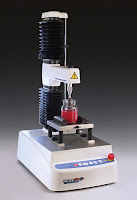Penetration is the method used to measure consistency which is the resistance a sample exhibits to deformation by an applied force.
A Penetrometer is a device that provides a rapid empirical method for measuring the denseness, compaction, consistency or penetrability of a wide variety of solid, semisolid, food and non-food products. These typically include soil, agricultural produce, or semisolid petroleum products in the pharmaceutical (such as creams and ointments), civil engineering, agriculture, geology and scientific exploration industries.
It is a simple device that was invented in 1846 and typically measures the resistance of a substance to penetration to a given depth by a weight-driven cone or needle of a specific shape by gravity at a specific temperature. This penetration is indicated in penetration units of 0.1mm or directly in millimetres which allows a rating of the plasticity or consistency of the sample. Over time, many standard methods have developed that use this principle but vary in the penetrometer cone/needle geometry, time and load applied.
The Plus range of Texture Analysers can accommodate a Penetrometer unit to provide this measurement and extend the range of applications for the instrument.
How the Penetrometer works
Typically, a standard cone or needle is automatically released from the penetrometer rig and allowed to free-fall into a contained sample for 5 seconds (or a different specified cone release interval) at a constant temperature after which time the cone is automatically retained. The depth of penetration of the cone or needle into the sample is measured and recorded in mm, PU (Penetrometer) units along with the additional measurement of apparent yield stress (σapp). The deeper the cone/needle sinks into the material, the softer the material is.
 |
| The above graph shows the cone release interval 5 seconds. |
 |
| Typical spreadsheet in Exponent Connect software |
 |
Penetrometer probe |
Measuring consistency – a comparison to consider
There is a Texture Analysis test for virtually any physical property. Contact Stable Micro Systems today to learn more about our full range of solutions.
For more information on how to measure texture, please visit the Texture Analysis Properties section on our website.
No-one understands texture analysis like we do!
Get in touch to discuss your specific test requirements





No comments:
Post a Comment